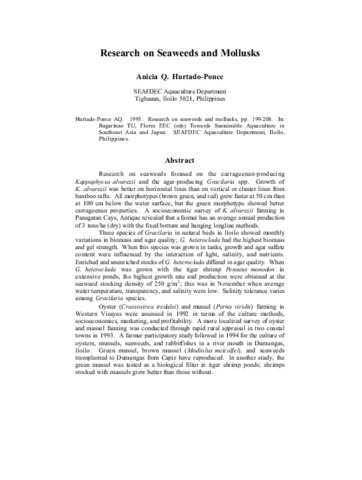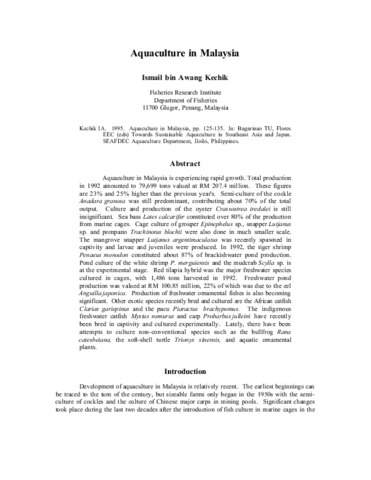Economic analysis of stake and rack-hanging methods of farming oysters (Crassostrea iredalei) in the Philippines
- Global styles
- MLA
- Vancouver
- Elsevier - Harvard
- APA
- Help

View/
Date
1998Page views
550ASFA keyword
AGROVOC keyword
Taxonomic term
Metadata
Show full item record
Share
Abstract
The cost efficiency of stake and rack-hanging methods of farming oysters are compared. Annual costs and returns data for both methods were obtained from a socioeconomic survey conducted in 1991 at the Aquaculture Department of the Southeast Asian Fisheries Development Center (SEAFDEC/AQD). On average, 14 kg m−2 (shell-on) and 22 kg m−2 (shell-on) were produced using the stake and rack-hanging methods, respectively. The translog cost function for 58 oyster farms was estimated using iterative seemingly unrelated regression (SUR). Statistical analysis indicates that the higher production from the rack-hanging method is significantly different (α=0.10) from the production using the stake method. The cost-efficient method varied based on production levels. At output levels less that 9044 kg (shell-on), the rack-hanging method had lower average cost per unit, and for higher production levels the stake method had the lower average costs. Similar conclusions were drawn from the marginal cost analysis. Results imply when production is less than 9044 kg, then the most efficient technology is the rack-hanging method and if production is greater than 9044 kg, the most efficient method is the stake method.
Suggested Citation
Samonte-Tan, G. P. B., & Davis, G. (1998). Economic analysis of stake and rack-hanging methods of farming oysters (Crassostrea iredalei) in the Philippines. Aquaculture , 160(3-4), 239-249. https://doi.org/10.1016/S0044-8486(97)00231-7
Type
ArticleISSN
0044-8486Collections
- Journal Articles [1258]
Related items
Showing items related by title, author, creator and subject.
-
Research on seaweeds and mollusks
Hurtado-Ponce, Anicia Q. (Aquaculture Department, Southeast Asian Fisheries Development Center, 1995)Research on seaweeds focused on the carrageenan-producing Kappaphycus alvarezii and the agar-producing Gracilaria spp. Growth of K. alvarezii was better on horizontal lines than on vertical or cluster lines from bamboo ... -
Aquaculture in Malaysia
Kechik, Ismail bin Awang. (Aquaculture Department, Southeast Asian Fisheries Development Center, 1995)Aquaculture in Malaysia is experiencing rapid growth. Total production in 1992 amounted to 79,699 tons valued at RM 207.4 million. These figures are 23% and 25% higher than the previous year's. Semi-culture of the cockle ... -
A method of culturing/ growing high-quality edible oysters (Crassostrea spp. and Magallana bilineata)
Lebata-Ramos, Ma. Junemie Hazel; Southeast Asian Fisheries Development Center/Aquaculture Department (Intellectual Property Office of the Philippines, 2024-11-18)This utility model discloses a process of culturing/ growing high-quality edible oysters (Crassostrea spp. and Magallana bilineata) comprising the steps: selecting grow-out culture sites, deploying substrates ...






